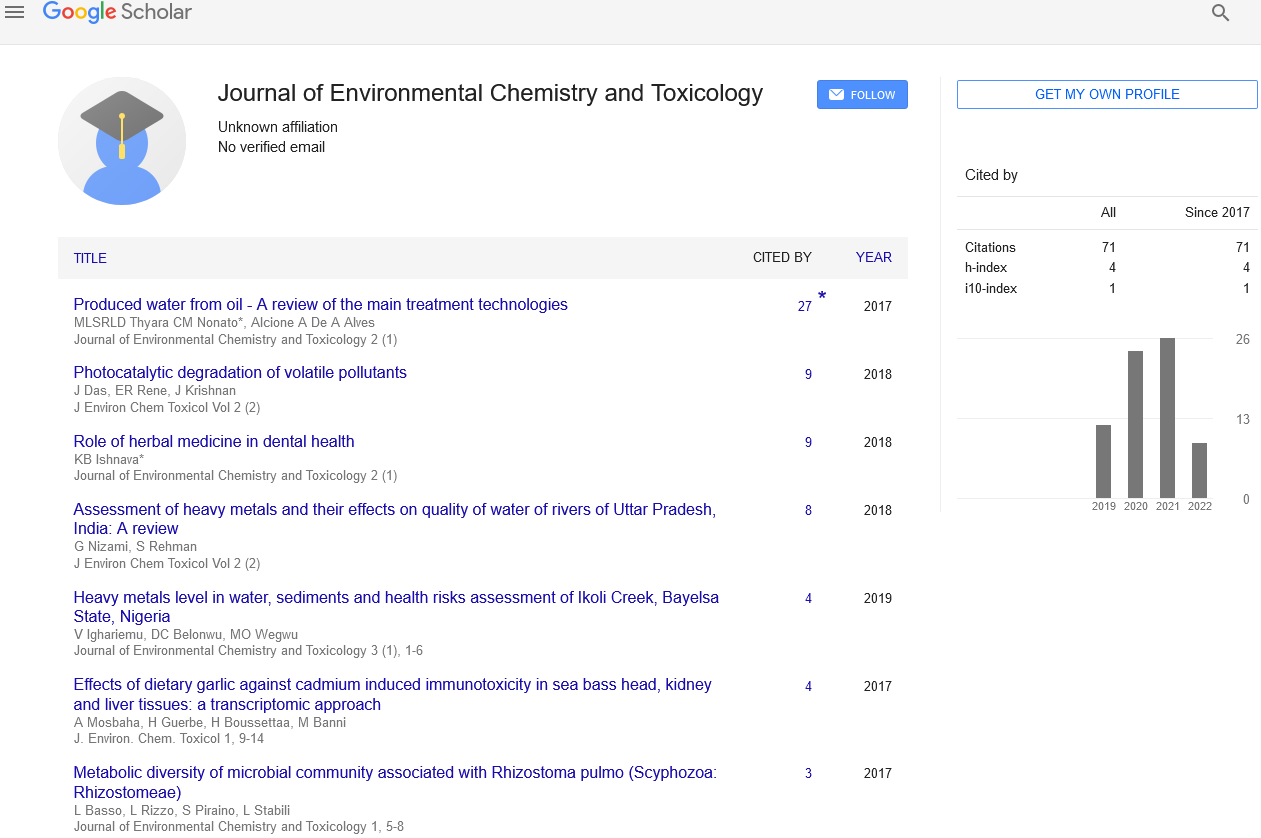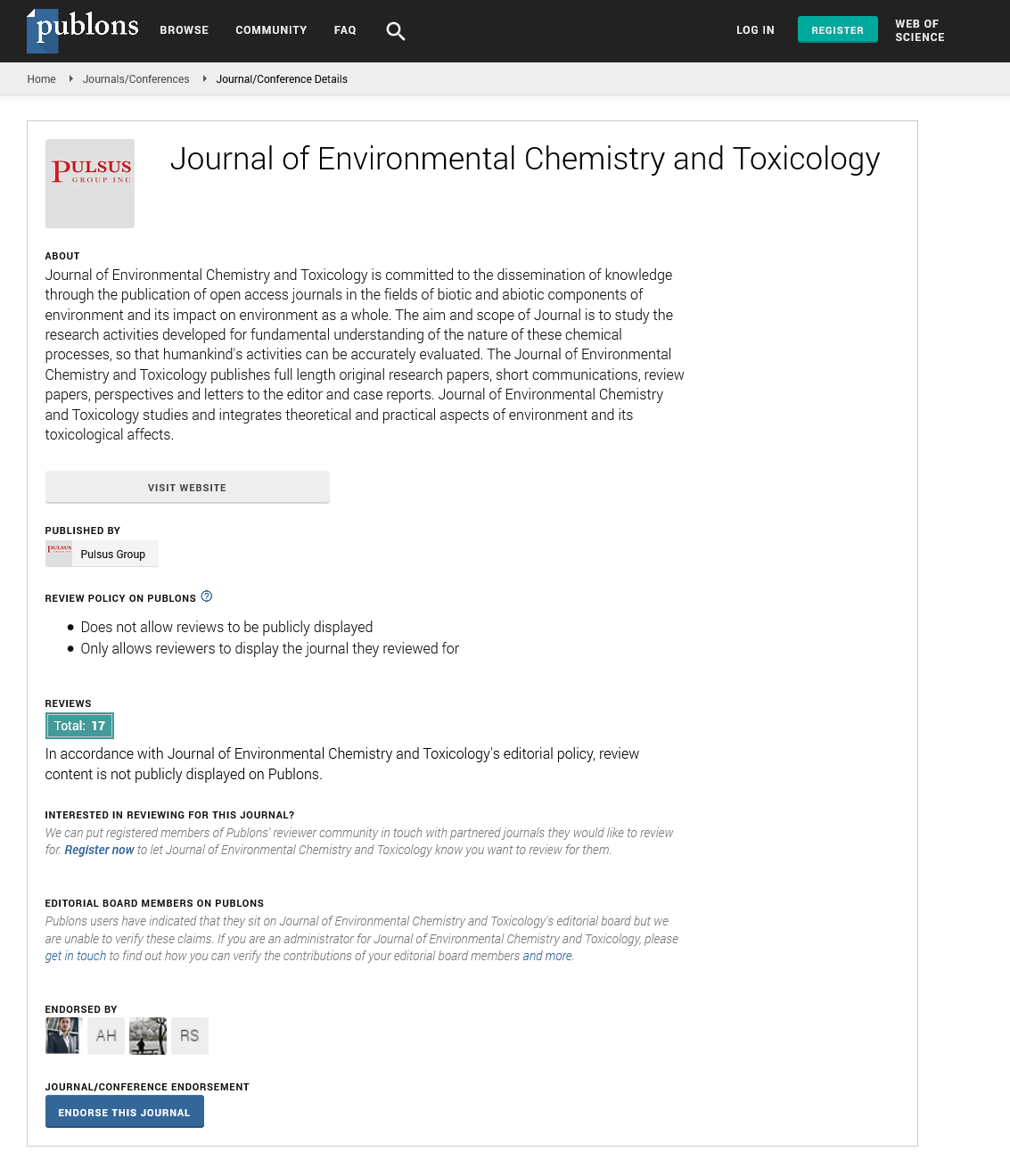Sustainable waste management: The anaerobic Digestion conundrum
Received: 31-Aug-2017 Accepted Date: Sep 01, 2017; Published: 10-Sep-2017
This open-access article is distributed under the terms of the Creative Commons Attribution Non-Commercial License (CC BY-NC) (http://creativecommons.org/licenses/by-nc/4.0/), which permits reuse, distribution and reproduction of the article, provided that the original work is properly cited and the reuse is restricted to noncommercial purposes. For commercial reuse, contact reprints@pulsus.com
The human population has more than doubled over the past fifty years and this is accompanied by astronomical increase in waste accumulation across the globe. Although not often considered an immediate threat by individuals going about their daily businesses-relative to so-called toxic chemicals, organic wastes resulting from domestic food materials and food processing plants pose a significant threat to surface waters due to the likelihood of excessive nutrient deposition (particularly in the form of nitrogen and phosphorus), which ultimately causes eutrophication, if unbridled (1). Interestingly, increase in the incidence of eutrophication is another trend that is in parallel with the human population profile [1].
Attempts to manage organic wastes have reignited interest in an old technology - anaerobic digestion (AD) - for waste treatment. Whereas AD offers an excellent means for treating organic wastes, it is not completely devoid of challenges. Anaerobic digestate, the waste sludge resulting from AD is typically rich in total ammonia nitrogen (TAN) with considerable levels of phosphorus and potassium [2,3], which are a delicacy for eutrophicationcausing algae. Although anaerobic digestate is used as fertilizer, this practice is coming under strict regulation by environmental protection agencies in most countries, particularly in the developed world [4].
To prevent run off of TAN, phosphorus and potassium to surface waters, the spread of anaerobic digestate on snow-covered or frozen land is banned in most countries in Europe and North America [4,5]. In fact, anaerobic digestate poses a more serious threat to underground waters, which serve as the source of drinking water for several rural communities. This is because ammonia is readily converted to nitrate; a highly mobile form of nitrogen in soil and water by soil bacteria, and nitrate has been implicated in cancer and methemoglobinemia (blue baby syndrome; 6).
The question that therefore arises is: How do we manage the waste from AD (a waste management technology in itself)? It is worthy of mention though that technologies for removal of TAN (the main nutrient in anaerobic digestate) from the digestate exist. These include biological and physicochemical processes such as struvite precipitation, ammonia stripping, adsorption with zeolite, activated charcoal and other adsorptive materials, anaerobic ammonia oxidation (ANAMMOX) and aerobic bacterial oxidation [5-11]. However, these technologies can incur additional operating costs, thus making them less attractive, especially to profit-driven large-scale AD facilities. Similarly, farmers are cost averse; hence, they are less likely to adopt any of the above listed methods.
Tightening regulations, leading to the closure of lanfills and a firm stance by most local, state and regional governments against the opening new ones, in addition to increasing societal clamor to preserve the environment due to climate change have prompted an upsurge in commercial AD. Further, cities and municipalities are adopting AD as a means for offsetting electricity costs at wastewater treatment facilities (by conversion of biogas to electricity) and for treating nitrogen-replete wastes that would otherwise violate TAN discharge limits by wastewater treatment facilities into surface waters. As cities expand in population, organic waste generation – both domestic and industrial – ultimately increases.
Against a backdrop of existing regulations, it is imperative therefore, to devise more sustainable means for disposing of anaerobic digestate. Some treatment plants and farms store anaerobic digestate and animal manure in lagoons or underground concrete tanks, pending the time that they can be safely spread on the field [5]. Consequently, ammonia is lost during storage leaving behind a liquid stream that lacks the requisite nutrients for plant growth [5]. Additionally, this practice increases the release of ammonia into the surrounding air, especially with large operations, which constitutes a nuisance to the surrounding community in the form of foul odor and potential health hazards in the long run.
In light of these, robust large-scale biotechnological operations such as fermentative production of fuels and chemicals might offer an exit route for dispensing of excess nutrients in anaerobic digestate (when farm application is not feasible or is incapable of accommodating large volumes of digestate from large-scale AD operations). The major nutrients in anaerobic digestate are key nutrients for industrial microorganisms. Thus, given the sheer scale of industrial fermentative operations (which typically match or outstrip AD operations, in terms of plant/bioreactor sizes), developing cheap and effective technologies for extracting and utilizing nitrogen and phosphorus from anaerobic digestate as nutrients in large-scale fermentative operations (for the production of fuels and chemicals) would certainly convert a major waste stream into a value-added product; i.e., nutrients for industrial fermentation processes. More importantly, this would relieve the storage burden currently shouldered by farmers, commercial AD and municipal plants, particularly during the winter months. Further, the likelihood of unwanted seeping of ammonia or nitrate and phosphorus into surface and underground waters or into the surrounding air would be greatly reduced.
Whereas, research efforts in this area have largely explored means of reducing the loss of ammonia during storage or improving physico-chemical and biological methods of nutrient removal, it should be noted that nutrient removal alone is not enough. To achieve a truly sustainable practice, it is imperative to pursue technologies (which may include affordable hybrids of existing technologies for nutrient removal) that seek to convert anaerobic digestate into supplements to, or a liquid platform for industrial medium formulation. Such technology(ies) would lead to near-zero waste-generating practices by converting a rather ‘messy’ effluent stream into a value-added product. More so, valorization of anaerobic digestate may encourage more farmers and municipal wastewater treatment facilities to adopt AD in the wake of growing societal consciousness for environmental conservation.
REFERENCES
References
- Driscoll CT, Whitall D, AberJ, et al. Nitrogen pollution in the North East United States: Sources, effects and management options. Bioscience. 2003;53:357-74.
- Al Seadi T, Drosg B, Fuchs W, et al. Biogas digestate quality and utilization. In: Wellinger A, Murphy J, Baxter D. (Eds.), The Biogas Handbook – Science, Production and Applications. Woodhead Publishing. 2013;267-301.
- Bauer A, Mayr H, Hopfner-Sixt, et al. Detailed monitoring of two biogas plants and mechanical solid–liquid separation of fermentation residues. J Biotechnol. 2009;142:56-63.
- European Commission, 1991, Council Directive of 12 December 1991 Concerning the Protection of Waters Against Pollution Caused by Nitrates from Agricultural Sources. 1991.
- Svehla P, Radechovska H, Pacek L, et al. Nitrification in a completely stirred tank reactor treating the liquid phase of digestate: The way towards rational use of nitrogen. Waste Management. 2017;64: 96-106.
- Chambers PA, Guy M, Roberts ES, et al. Nutrients and their impacts on the Canadian environment. Agricultural and Agri-Food Canada, Environment Canada, Fisheries and Oceans Canada. Health Canada and Natural Resources Canada, Ottawa. 2001.
- Münch EV, Barr K. Controlled struvite crystallisation for removing phosphorus from anaerobic digester side streams. Water Res. 2001;35:151-9.
- Kizito S, Wu S, Kirui WK, et al. Evaluation of slow pyrolyzed wood and rice husks biochar for adsorption of ammonium nitrogen from piggery manure anaerobic digestate slurry. Science of Total Environment. 2015;505:102-12.
- Cardoso AM, Martha B, Horn MB, et al. Integrated synthesis of zeolites 4A and Na–P1 using coal fly ash for application in the formulation of detergents and swine wastewater treatment. J Hazard Mater. 2015;287:69-77.
- Kuenen JG. Anammox bacteria: From discovery to application. Nat Rev Microbiol. 2008;6:320-6.
- Slieckers AO, Third KA, Abma W, et al. CANON and Anammox in a gas lift bioreactor. FEMS Microbiol Lett. 2003;218:339-44.






